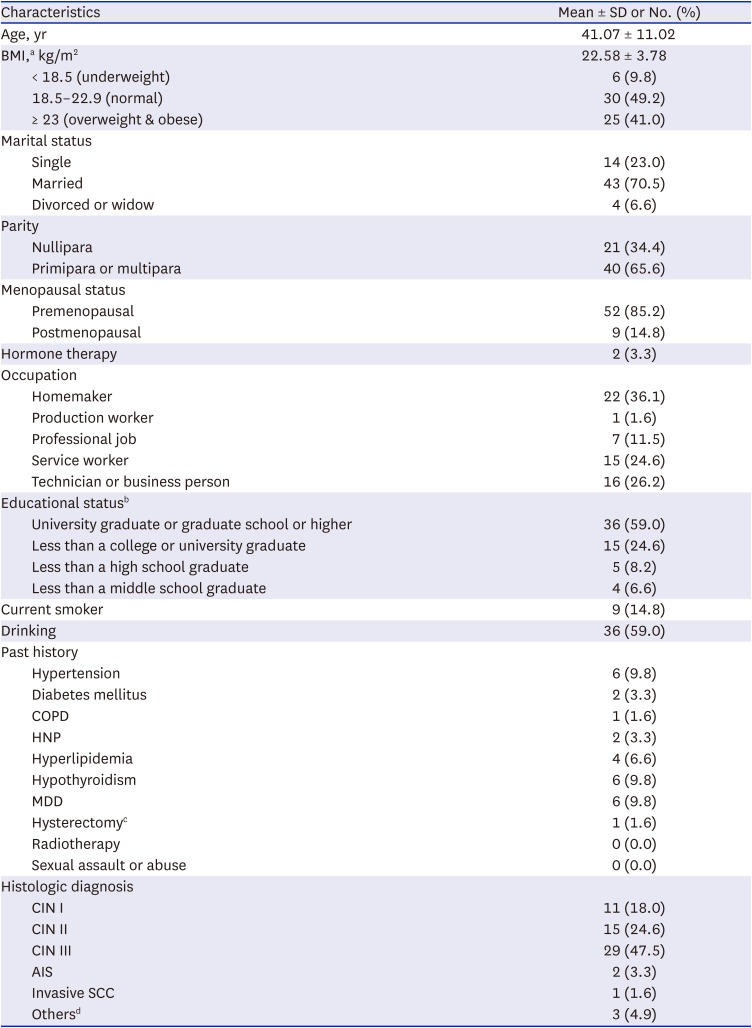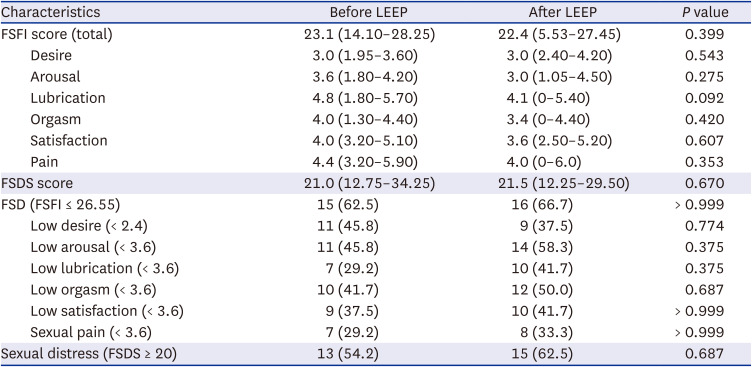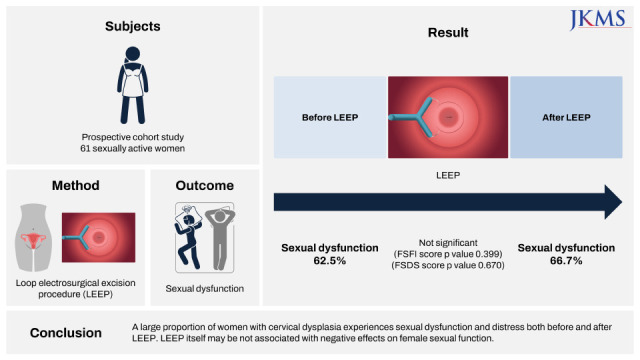1. Laumann EO, Paik A, Rosen RC. Sexual dysfunction in the United States: prevalence and predictors. JAMA. 1999; 281(6):537–544. PMID:
10022110.
2. Shifren JL, Monz BU, Russo PA, Segreti A, Johannes CB. Sexual problems and distress in United States women: prevalence and correlates. Obstet Gynecol. 2008; 112(5):970–978. PMID:
18978095.
3. American College of Obstetricians and Gynecologists’ Committee on Practice Bulletins—Gynecology. Female sexual dysfunction: ACOG practice bulletin clinical management guidelines for obstetrician-gynecologists, number 213. Obstet Gynecol. 2019; 134(1):e1–18. PMID:
31241598.
4. American Psychiatric Association. Diagnostic and Statistical Manual of Mental Disorders. 5th ed. Arlington, TX, USA: American Psychiatric Association;2013.
5. Hasson HM. Cervical removal at hysterectomy for benign disease. Risks and benefits. J Reprod Med. 1993; 38(10):781–790. PMID:
8263867.
6. Saini J, Kuczynski E, Gretz HF 3rd, Sills ES. Supracervical hysterectomy versus total abdominal hysterectomy: perceived effects on sexual function. BMC Womens Health. 2002; 2(1):1. PMID:
11825343.

7. Kilkku P, Grönroos M, Hirvonen T, Rauramo L. Supravaginal uterine amputation vs. hysterectomy. Effects on libido and orgasm. Acta Obstet Gynecol Scand. 1983; 62(2):147–152. PMID:
6868963.

8. Brucker SY, Taran FA, Bogdanyova S, Ebersoll S, Wallwiener CW, Schönfisch B, et al. Patient-reported quality-of-life and sexual-function outcomes after laparoscopic supracervical hysterectomy (LSH) versus total laparoscopic hysterectomy (TLH): a prospective, questionnaire-based follow-up study in 915 patients. Arch Gynecol Obstet. 2014; 290(6):1141–1149. PMID:
24973868.

9. Wydra D, Ciach K, Sawicki S, Wilhelm J, Emerich J. Comparison of sexual behavior after total or subtotal hysterectomy. Ginekol Pol. 2004; 75(4):274–280. PMID:
15181865.
10. Kim DH, Lee YS, Lee ES. Alteration of sexual function after classic intrafascial supracervical hysterectomy and total hysterectomy. J Am Assoc Gynecol Laparosc. 2003; 10(1):60–64. PMID:
12554996.

11. Kuppermann M, Summitt RL Jr, Varner RE, McNeeley SG, Goodman-Gruen D, Learman LA, et al. Sexual functioning after total compared with supracervical hysterectomy: a randomized trial. Obstet Gynecol. 2005; 105(6):1309–1318. PMID:
15932822.

12. Duesing N, Schwarz J, Choschzick M, Jaenicke F, Gieseking F, Issa R, et al. Assessment of cervical intraepithelial neoplasia (CIN) with colposcopic biopsy and efficacy of loop electrosurgical excision procedure (LEEP). Arch Gynecol Obstet. 2012; 286(6):1549–1554. PMID:
22865036.

13. Kjellberg L, Tavelin B. ‘See and treat’ regime by LEEP conisation is a safe and time saving procedure among women with cytological high-grade squamous intraepithelial lesion. Acta Obstet Gynecol Scand. 2007; 86(9):1140–1144. PMID:
17712659.

14. Ramírez SI, Lutzkanin A. Management of cervical dysplasia using office loop electrosurgical excision procedure. Prim Care. 2021; 48(4):583–595. PMID:
34752271.

15. Kim HY, So HS, Park KS, Jeong SJ, Lee JY, Ryu SB. Development of the Korean-version of Female Sexual Function Index (FSFI). Korean J Androl. 2002; 20(1):50–56.
16. Rosen R, Brown C, Heiman J, Leiblum S, Meston C, Shabsigh R, et al. The Female Sexual Function Index (FSFI): a multidimensional self-report instrument for the assessment of female sexual function. J Sex Marital Ther. 2000; 26(2):191–208. PMID:
10782451.

17. Wiegel M, Meston C, Rosen R. The Female Sexual Function Index (FSFI): cross-validation and development of clinical cutoff scores. J Sex Marital Ther. 2005; 31(1):1–20. PMID:
15841702.

18. Jiann BP, Su CC, Yu CC, Wu TT, Huang JK. Risk factors for individual domains of female sexual function. J Sex Med. 2009; 6(12):3364–3375. PMID:
19758287.

19. Kim YH, Kim SM, Kim JJ, Cho IS, Jeon MJ. Does metabolic syndrome impair sexual function in middle- to old-aged women? J Sex Med. 2011; 8(4):1123–1130. PMID:
21235723.

20. Derogatis LR, Rosen R, Leiblum S, Burnett A, Heiman J. The Female Sexual Distress Scale (FSDS): initial validation of a standardized scale for assessment of sexually related personal distress in women. J Sex Marital Ther. 2002; 28(4):317–330. PMID:
12082670.

21. Han C, Kim HC, Kang SH, Moon DG, Kim JJ, Choi JY. Validity and reliability of Korean version of the Female Sexual Distress Scale (FSDS). Korean J Androl. 2004; 22(2):68–74.
22. Michaan N, Loboda N, Ochshorn I, Tzur Y, Cohen A, Grisaru D, et al. The effect of cervical conization on women’s’ sexual function and psychological health, a prospective observational study. J Sex Med. 2022; 19(2):257–262.

23. Hellsten C, Lindqvist PG, Sjöström K. A longitudinal study of sexual functioning in women referred for colposcopy: a 2-year follow up. BJOG. 2008; 115(2):205–211. PMID:
17903228.

24. Inna N, Phianmongkhol Y, Charoenkwan K. Sexual function after loop electrosurgical excision procedure for cervical dysplasia. J Sex Med. 2010; 7(3):1291–1297. PMID:
19968775.

25. Song SH, Jeon H, Kim SW, Paick JS, Son H. The prevalence and risk factors of female sexual dysfunction in young Korean women: an internet-based survey. J Sex Med. 2008; 5(7):1694–1701. PMID:
18422495.

26. Ma J, Kan Y, Zhang A, Lei Y, Yang B, Li P, et al. Female sexual dysfunction in women with non-malignant cervical diseases: a study from an urban Chinese sample. PLoS One. 2015; 10(10):e0141004. PMID:
26473480.

27. Madbouly K, Al-Anazi M, Al-Anazi H, Aljarbou A, Almannie R, Habous M, et al. Prevalence and predictive factors of female sexual dysfunction in a sample of Saudi women. Sex Med. 2021; 9(1):100277. PMID:
33168467.

28. Ishak IH, Low WY, Othman S. Prevalence, risk factors, and predictors of female sexual dysfunction in a primary care setting: a survey finding. J Sex Med. 2010; 7(9):3080–3087. PMID:
20584130.

29. Shin H, Min B, Park J, Son H. A 10-year interval study to compare the prevalence and risk factors of female sexual dysfunction in Korea: the Korean Internet Sexuality Survey (KISS) 2014. Int J Impot Res. 2017; 29(2):49–53. PMID:
27928152.

30. Lewis RW, Fugl-Meyer KS, Bosch R, Fugl-Meyer AR, Laumann EO, Lizza E, et al. Epidemiology/risk factors of sexual dysfunction. J Sex Med. 2004; 1(1):35–39. PMID:
16422981.

31. McCabe MP, Sharlip ID, Lewis R, Atalla E, Balon R, Fisher AD, et al. Risk factors for sexual dysfunction among women and men: a consensus statement from the Fourth International Consultation on Sexual Medicine 2015. J Sex Med. 2016; 13(2):153–167. PMID:
26953830.








 PDF
PDF Citation
Citation Print
Print




 XML Download
XML Download